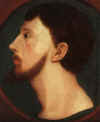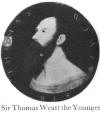
Sir Thomas WYATT, "The Younger"
Born: 1521
Died: 11 Apr 1554, London, England
Father: Thomas "The Elder" WYATT (Sir)
Mother: Elizabeth BROOKE
Married: Jane HAWTE (b. 1522 - d. AFT 1595) (dau. of Sir William Hawte and Maria Guildford) 1537, Bishopsbourne and Wavering, England
Children:
|
2. Anne WYATT 4. Jane WYATT 5. Richard WYATT |
6. Carolus WYATT 7. Arthur WYATT 8. Henry WYATT 9. Joyce WYATT 10. Ursula WYATT |
For More Information see:
Born at Allington Castle in 1521; only son of Sir Thomas, the Elder, by his wife, Elizabeth Brooke, daughter of Thomas Brooke, third Lord Cobham; the Duke of Norfolk was one of his godfathers. His parents were already estranged, his father rarely at home, being either abroad on the Kingís business or at Court. In boyhood he is said to have accompanied his father on an embassy to Spain, where the elder Sir Thomas Wyatt was threatened by the Inquisition. To this episode has been traced an irremovable detestation of the Spanish government, but the anecdote is probably apocryphal. All that is positively known of his relations with his father while the latter was in Spain is found in two letters which the elder Wyatt addressed from Spain to the younger, then fifteen years old. The letters give much sound moral advice.
At 15 he was appointed Esquire of the Body, to Henry VIII, and Joint Constable of Conysborough Castle (Yorkshire) post previously held by father and grandfather.
Barely 16 he married Jane Hawte, daughter and co-heiress of Sir William Hawte of Bishopsbourne, and Maria Guildford. She bore him 10 children, of whom 3 married and left issue.
He was brought up as a catholic. He is described as 'twenty-one years and upwards' in the 'inquisition post mortem' of his father, which was dated 8 Jan 1542/43. He succeeded on his father's death in 1542 to Allington Castle and Boxley Abbey in Kent, with much other property. But the estate was embarrassed, and he parted with some outlying lands on 30 Nov 1543 to the King, receiving for them 3,669l.8s. 2d. In 1542 he alienated, too, the estate of Tarrant in Dorset in favour of Francis Wyatt, whose mother was Elizabeth, dau. of Sir Edward Darrel of Littlecote. Various authors and authorities give conflicting accounts of Elizabeth Darrell’s connection with the Wyatts. Fore some authors, she was the mistress of the elder Sir Thomas, for others, she bore her sons to the younger Wyatt. Cross references fit the cases of both men - is it possible that she became the mistress of both men?
Thomas Wyatt served as volunteer in wars against France BET 1543-50 and given command of troops. He was Knighted in 1547. During this period Henry VIII died, succeeded by his son Edward VI. When Wyatt returned to England he took no part in public affairs.
Wyatt was of somewhat wild and impulsive temperament. At an early age he had made the acquaintance of his father's disciple, Henry Howard, Earl of Surrey. In 1545 he was in London, with Surrey and a band of boon companions, and went roistering noisily along narrow, dark, stinking unlit streets of the city, breaking expensive precious glass windows of citizens houses and damaging ecclesiastical glass windows. They were arrested and brought to trial before the dreaded Privy Council on 1 Apr, charging with acts of violence and in addition to "eating meat in Lent". Surrey explained that his efforts were directed to awakening the citizens of London to a sense of sin. Wyatt was inclined to deny the charges. But there seems little doubt that they were not altogether sober when the offences were committed. It was known that they were in the habit of frequenting a "house" kept by Mistress Arundel, and she came to their aid at the trial. The three young men were sent to prison in the Poultry but was later removed to the Tower. He remained in the Tower till 3 May. When released he volunteered to join the English contingent fighting in alliance with Carlos V of Spain in Flanders. It was there that he came to dislike the Spaniards. He was a most successful soldier, showing courage, initiative and ability to command. He was wounded on one occasion; was given command of 1000 footmen; and later made Commander of the fortress of Boulogne; serving seven years abroad.
In the autumn of 1543 Wyatt joined a regiment of volunteers which Surrey raised at his own expense to take part in the siege of Landrecies. Wyatt distinguished himself in the military operations, and was highly commended by Thomas Churchyard, who was present. (Churchyard, Pleasant Discourse of Court and of Wars, 1596). In 1544 Wyatt took part in the siege of Boulogne and was given responsible command next year. When Surrey became governor he joined the English council there (14 Jun 1545). Surrey, writing to Henry VIII, highly praised Wyatt's "hardiness, painfulness, circumspection, and naturaldisposition to the war". He seems to have remained abroad until the surrender of Boulogne in 1550. In Nov 1550 he was named acommissioner to delimit the English frontier in France, but owing toill-health was unable to act.
After his war service he retired to Allington as a country gentleman. Earlier he took part in the earlier uprising by the Duke of Northumberland, to put Lady Jane Grey, a Protestant and descendent of Henry VIII, on the throne. Subsequently he claimed to have served Queen Mary. But he took no well defined part in public affairs at home until he learned of Queen Mary's resolve to marry Felipe of Spain.
Wyatt regarded the step as an outrage on the nation's honour. This marriage would bring England under Roman Catholic and Spanish influence. But, according to his own account, never thought of publicly protesting against it until he received an invitation from Edward Courtenay, Earl of Devon, to join in a general insurrection throughout the country for the purpose of preventing the accomplishment of the Queen's plan. He cheerfully undertook to raise Kent. Help was vaguely promised him by Noailles, the French Ambassador. Wyatt invited friends to Allington Castle, got their support, raised 4000 men in Maidstone, and marched on London in a rebellion after called "Wyatt's rebellion". Wyatt taken to the Tower as a traitor. Attained, beheaded 11 Apr 1554 age 33. After he was beheaded, his body was subjected to all the barbarities that formed part of punishment for treason. Next day his head was hung to a gallows on 'Hay Hill beside Hyde Park', and subsequently his limbs were distributed among gibbets in various quarters of the town (MACHIN, Diary, p 60). His head was stolen on 17 Apr.
His execution was largely due to pressure by Bishop Gardiner and Simon Renard, Spanish Ambassador. His posthumous reputation was that of a martyr to the national cause.
According to some accounts, Jane Hawte was sent for after Wyatt's arrest and promised he would be spared if she could convince him to implicate Elizabeth Tudor in treason. He refused. Until Queen Mary provided an annuity of £200 in 1555, the family was destitute. Jane was allowed to reclaim her husbandís goods and some of his property.
 |
The Twysden Roll contained the pedigrees and the arms of Twysden, Wyatt,
Scott (a member of which family had married a sister Anne
Wyatt) as well as the Pedigree and arms of the
family of Elizabeth Woodville, the Queen
of Edward IV, whose aunt (also named Elizabeth
Woodville) had married in about 1430, William
Hawte, an ancestor of the wife of Sir
Thomas Wyatt, the younger. The Hawtes of
Bishopsbourne and Wavering Manor in Kent, who were neighbours of
the Wyatts of Allington, were an important local family. When the
Hawte male line became extinct in 1530, Jane Hawte,
one of her father’s co-heiresses, took the Wavering manor to
the Wyatts. 1530 Visitation
makes no mention of pedigree. At the "Visitation" in
1619 the pedigree presented was that of Roger Twysden,
as presented in 1578, who had married Anne,
a daughter of Sir Thomas Wyatt, the younger,
and included in the "Twysden Roll". George was the youngest son, born only a few days before the Rebellion, (others say he was 4 years at the time). According to the Patent Rolls the others were: Henry, Charles, Arthur, Jane, Anne, Mary. |
In 1571 Queen Elizabeth restored family in blood and arms through influence of distant kinswoman. By this time, George was the only surviving son.Properties of Boxley Abbey and Wavering Manor (but not Allington Castle, already given to John Ashley), thus relieving Jane’s poverty which had made her and her family dependent on the Hawte relatives and friends for 17 years. 1638 Appeared in the Archdeacons Court of Canterbury, 26 Oct 1638 and petitioned for the administration of the estate of her son Hawte Wyatt, later vicar of Boxley, Kent.
 to Bios Page
to Bios Page |
|
 to Peerage Page
to Peerage Page |
 to Home Page
to Home Page |